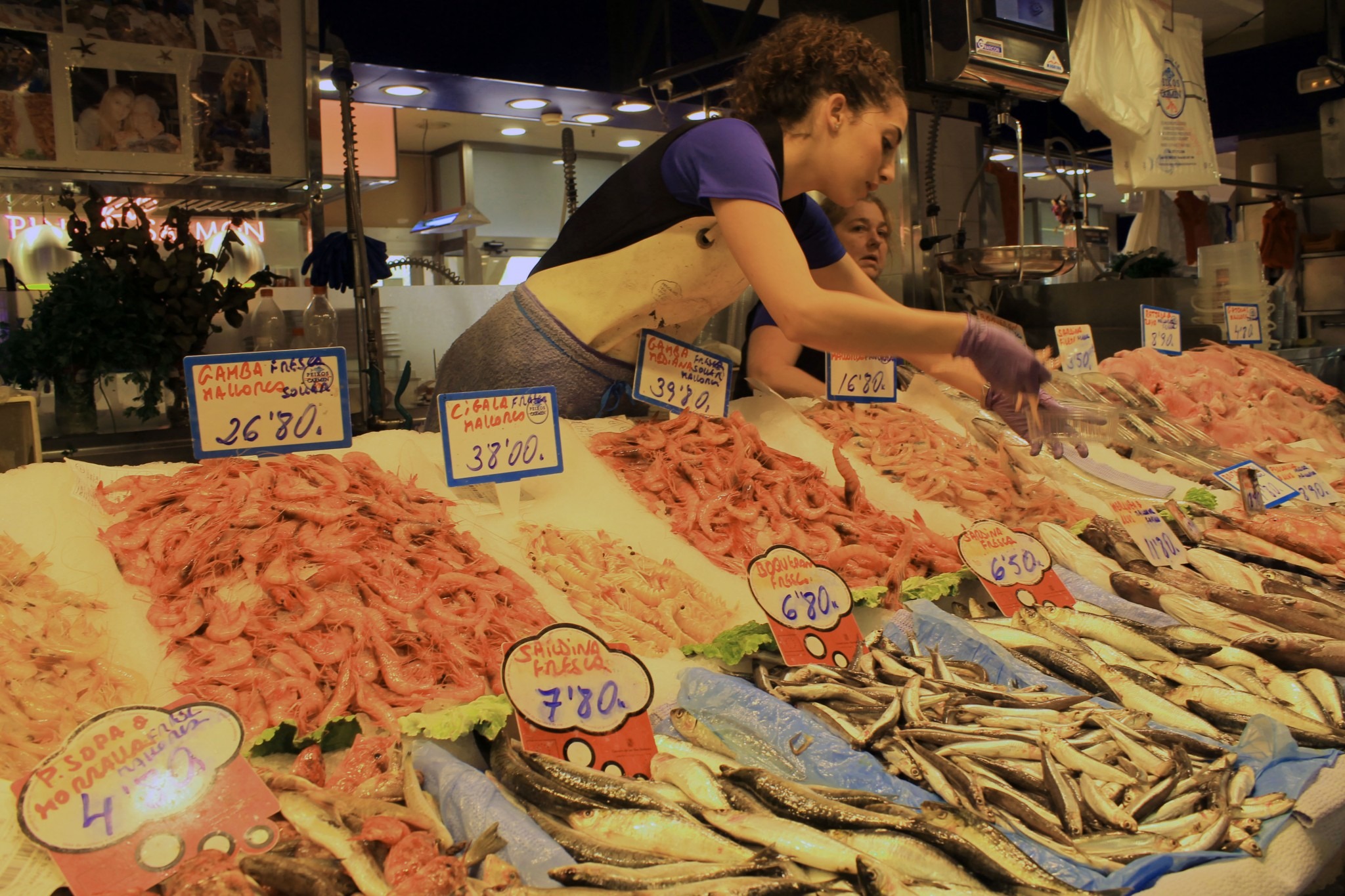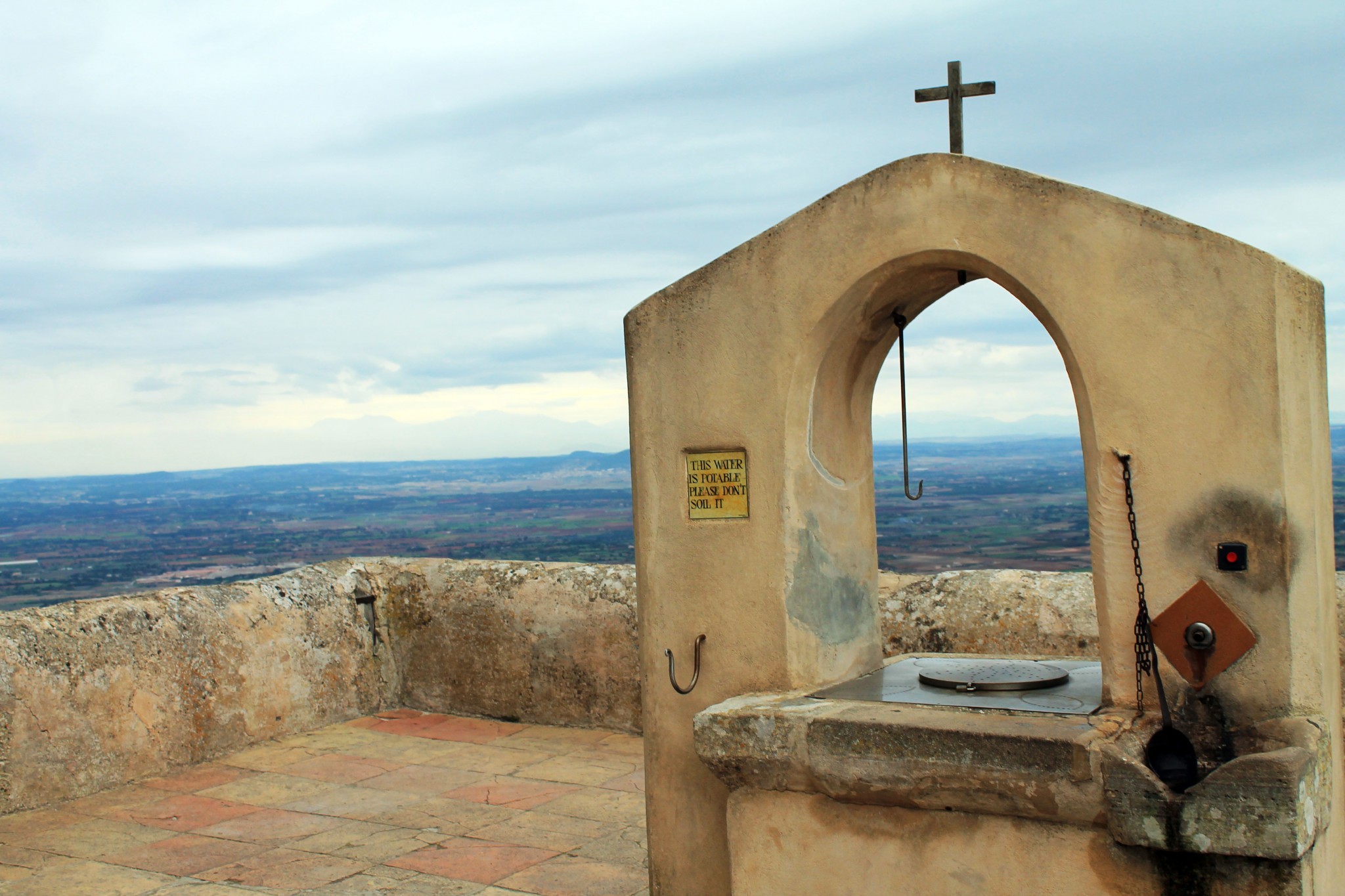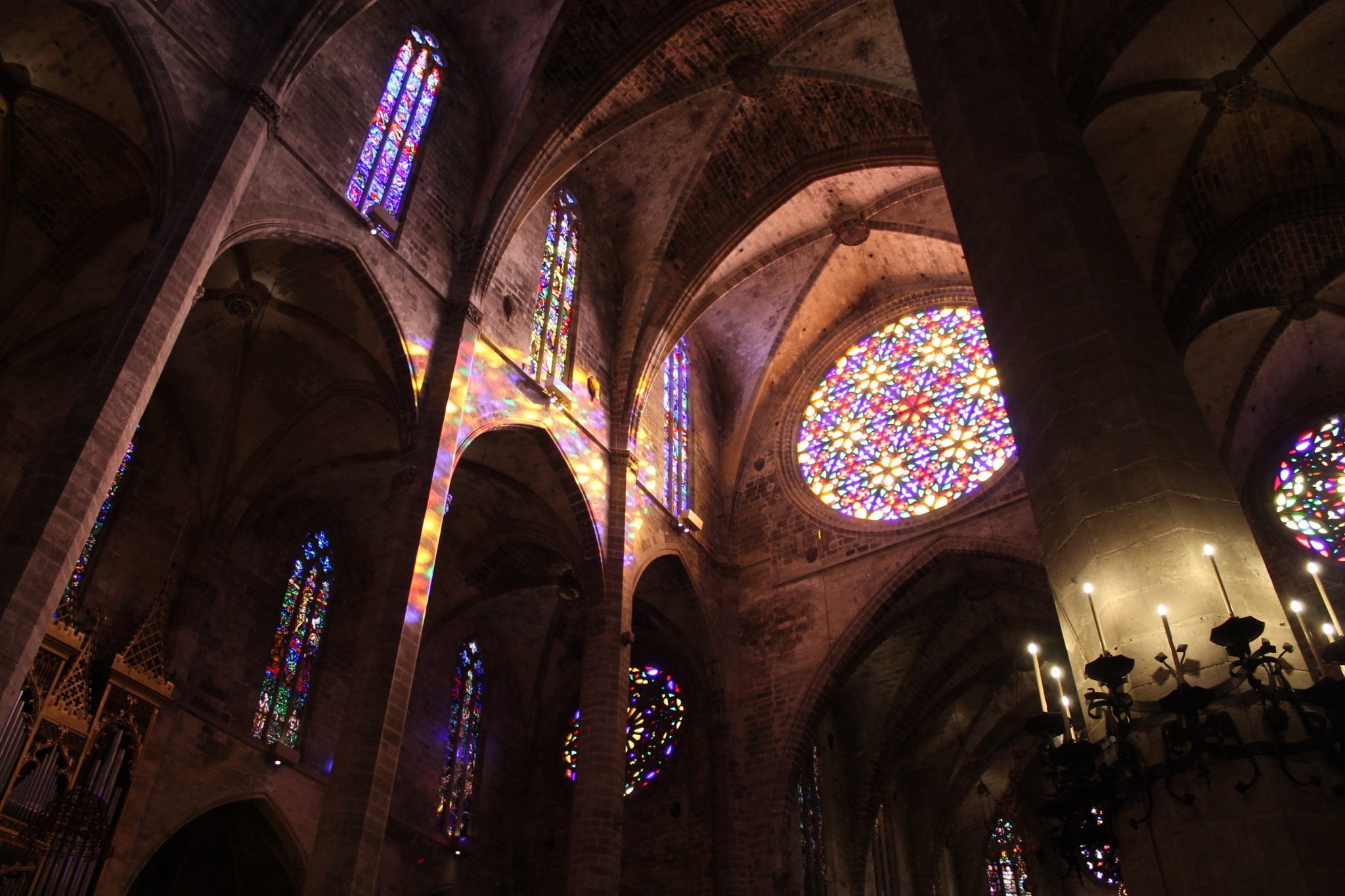
Mallorca is big enough to offer numerous activities all year round, but most of our visitors come here for the sun and the beautiful sea. I also enjoy the summer here, but sometimes it’s just too crowed and you really can’t enjoy it. My advice is to travel to Mallorca outside the high season (July, August) if you can. During May and June and September and October you’ll have the chance to relax outside of large crowds, save some money, and most of all, to discover the local culture and local life on the island. Read on for best local advice for what to see on Mallorca beyond the beach.

Mercat de l’Olivar in Palma | Photo by Marialaura Dolfi
Nothing gives you insight into local living quite like a visit to a market. In Palma (the capital and largest city on Mallorca), you can go to covered historical markets where you can buy fresh produce, fish, meat, and other local goods, or just soak up the scene and browse. If you want, you can even have lunch there in one of the tapas bars inside the markets. There, you can sample whatever is fresh and seasonal — not a bad way to spend your lunch hour. In these markets you can take pictures, breath in the history of the area, and feel like a local in town. My favourite markets are Mercat de Santa Catalina (the oldest food market in town), Mercat Pere Garau, and Mercat de l’Olivar because they’re colourful, extensive, and fun to shop in.
In addition to markets in Palma, there are many other markets that pop up all over the island that are well worth visiting. Each morning of the week there is a market in a different village. I love the local markets because there, you can really feel the authentic atmosphere. Among the other island markets you can visit, here are some of the best.
Felanitx market (weekly, Sundays): The covered market is open all the week, except on Monday, but the Sunday market has more stands outside the market building.
Santanyí market (Wednesday and Saturday morning): Located in the main square you’ll find stands of vegetables, fruits, and meat, but also wine and food stands where you can taste local snacks, or browse artisan stands with handmade baskets and other local products.
Campos market (Thursday and Saturday morning): This is a vintage and secondhand market, but you can also find fruits and vegetables. On Thursday, you’ll find more local goods and on Saturday the market is generally bigger.
Santa Maria market (Sunday): A large market where you can find vegetables and small plants for your garden.

Braided Palmito to prepare the baskets | Photo by Marialaura Dolfi
There’s souvenir shopping and then there’s finding local specialties that you can’t find anywhere else. When it comes to Mallorca, specialties include glassblowing, straw baskets, and textiles created by local artisans. These artisans are disappearing because everything now tends to be cheap and industrial, but the manual art can’t be compared with plastic industrial products. A hyper-local thing to do in Mallorca is to discover these artists in their workshops. You can also visit local museums to learn about our local artisan history and traditions.
Can Gordiola, a glassblowing museum in Algaida, has a long-standing glassblowing tradition. Most of Mallorcan glass artwork comes from this historical family-managed oven. It is the first artistic glass oven in Mallorca, running since 1719. The same family manages this handcrafted production today.
Teixtits Vicens in Pollença and Teixits Riera in Lloseta are two artisanal textile factories on the island. Teixits Riera is located inside an old Mallorcan house and the Riera family is one of the oldest in Mallorca working in this business. The ‘llengües’ fabrics are really stylish and high quality, and are a local textile expression of Mallorcan history and tradition. Llengües literally means ‘tongues,’ because the visual effect seems to be a repetition of colourful fire tongues. To produce this effect, these families created a handmade process of colouration and manufacturing that is still followed today. This process is called ikat, and it was imported into Europe during the silk commerce, but nowadays this tradition endures only on Mallorca. We use this kind of textile in curtains, tablecloths, cushions, furniture, or sofa covers. It is really interesting to see this process and to listen to the story of these traditional families who are working to produce excellent textiles with local raw materials even today.
Pere Pujol Rondaies Museum in Artà is an artisan museum in a family home, where, in each room there are different puppets, each representing the most important characters of the traditional stories that the grandmothers told their grandchildren in Mallorca. Pere Pujol is the name of the Artà sculptor who molded all of these characters into puppets. Demons, witches, and fairies fill the rooms of this old Mallorcan house. So it’s not just a museum, it’s an exhibition of local legends and stories. On the ground floor you’ll find local handmade products by other artisans from Artà, so you can do some authentic shopping.

Views from Sanctuary de Sant Salvador | Photo by Marialaura Dolfi
There are monasteries everywhere in the island and the cool thing is that they are located in beautiful places where you can take great pictures and enjoy gorgeous panoramas. The bad thing is that most of them are on the top of the mountains, so if it is cloudy, it’s possible that fog might roll in. The weather in Mallorca is really variable and you can have bad weather on one side of the island and good weather on the opposite side, so you just need to check the island forecast during the day to know where and when to go.
Lluc is a very big monastery on the island and every Mallorcan has gone there at least once in their life. The monastery, where you’ll also find a museum and botanic garden, is in the middle of a wonderful valley inside the stunning Sierra Tramuntana Mountain range. They are well equipped to receive visitors and you can even sleep here. There are bars and restaurants in the area and they also organise guided tours inside the museum and botanical garden.
If you want a quieter and more spiritual place, you can visit Monestir de Miramar (between Valdemossa and Deià). The website is only in Spanish, but you can find the exact Google location there. The Monastery has been transformed into a museum of sorts. To maintain it they ask you for an entrance fee which is around EUR 4 per person. The panoramas are beautiful, and very few people go there so the surroundings are peaceful.

Spectacular views from the Ermita de la Trinidad | Photo by Marialaura Dolfi
In Pollença, there is a restored monastery still inhabited called Santuari de la Mare de Déu del Puig. It is on the top of the hill and some monks live there today. Other beautiful monasteries include Sanctuary de Sant Salvador in Felanitx, Monti-Sion in Porreres, and Ermita de la Trinidad in Valldemossa.
Get some fresh air, exercise, and amazing scenery with a hike or bike ride on the island. There are trails along the sea coast, on the cliffs, on the mountains, and in the countryside. The panoramas are great and, except for in the summer months, the weather is perfect for walking. The longest and most popular track is the route GR 221, which runs all the way from the east to the west of the island and crosses the Sierra Tramuntana mountain range. The 135-kilmometre hike generally takes eight days and there are hostels located at the end of each stage for hikers.

View from the Sierra Tramunanta Mountains | Photo by Marialaura Dolfi
There are many other routes around the island and one of my favourites is the walk from Ermita de la Victoria to Refugi Coll Baix (around 5 hours and 30 minutes roundtrip). You will enjoy amazing views of the bay and the sea from the top. The Coll Baix beach is impressive, but I always prefer to have a nice picnic in the area in Coll Baix and admire the beach from the top.
A great building to visit in Palma is La Seu Cathedral (also called Palma Cathedral), an impressive example of Gothic architecture and one of Europe’s tallest Gothic structures. In front of the Cathedral you can also visit the Royal Palace of La Almudaina, which is a museum and the official residence when the King of Spain comes to Mallorca.

Inside the beautiful Palma Cathedral | Photo by Marialaura Dolfi
One of my favourite buildings in Palma is La Llotja. It is a rare example of Gothic architecture on Mallorca (beyond La Seu Cathedral). Behind La Llotja, you’ll find Es Baluard Museum of Modern & Contemporary Art, housed in a former military fortress. Outside the museum there is a nice terrace bar where you can sit to admire the cathedral and Bay of Palma.
If you like modernist art, stop by the Gran Hotel. It was the first luxury hotel in Palma, and has since been transformed into an art gallery with rotating exhibitions, as well as a cultural centre. On the ground floor there is a café that might seem a little pricey, but I love the atmosphere and it’s a great place to relax after some sightseeing.
Fans of Joan Miró should definitely visit the Fundació Pilar i Joan Miró, where you can admire many his artwork and learn about his life in Mallorca and his artistic influences. The museum is outside the city centre but it is easy to reach by public transportation or by car.
The caves of Mallorca contain spectacular stalactites and stalagmites, underground lakes, and prehistoric fossils. In Mallorca we have five different caves, all of which are equipped for any kind of visitor, including children and the elderly. In Artà you can find the Cuevas de Artà with a huge 22-metre-long stalactite. Near Palma, in the Génova area, there are the tiny Cuevas de Genova. In Campanet there are the Coves de Campanet, and near Porto Cristo you can enjoy the and Coves dels Hams, where there’s also an underground lake.

Winter landscape in Mallorca fields with almonds in flower | Photo by Marialaura Dolfi
For anyone who loves to shop, there are many original, local, authentic products from Mallorca that will surprise you and your friends. Here we have the central office of Camper shoes, which are designed in Mallorca. You’ll find the best prices at Festival Park Outlet, near Sa Cabaneta (between Palma and Inca). My advice is to go there on the last Thursday of every month, which is when all the shops offer their products at a 20% or 30% discount.
If you love artisan products, you can find a lot of interesting options in Palma’s city centre. Here you’ll find the historic Mimbreria Vidal, which sells all sorts of articles made of woven straw, from shoes to shopping bags. Another interesting shop in the same area where you can find handmade products is the Amenamen Studio, a shop that sells a variety of beautiful ceramics, housewares, and stylish décor items.